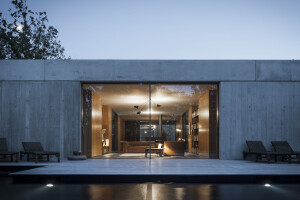The Smart Tree concept was born from a previous research project developed at theUniversity of Malaga with the purpose of recycling elements from the demolition of campus buildings to improve university teaching environments.Following in the footsteps of this rst experience, Smart Tree Mobilete is a sustainable prototype of an outdoor space for the study and optimization of thebehavior of bifacial solar modules.


The Jaén university campus has unused outdoor spaces due to comfort conditions that are not conducive to their use as a space for staying and enjoyment. With the intention of reversing this situation, the Smart Tree Mobilete prototype was designed to renaturalize these unused places by creating pleasant spaces in which to rest, work or teach. In addition, this prototype includes monitored energy sources and information technologies that make it a Technological Hub for social awareness of the need and advantages of the ecological transition process.


Smart Tree is conceived as a biotechnological tree whose mission is to rehabilitate the university’s outdoor spaces, promoting their use through the creation of green environments and connective services. Located at one of the campus entrances, this intervention transforms an unused place to provide users with a relaxed and friendly outdoor "co-working" space, which provides a microclimate of environmental and sensory comfort, and the technology to access renewable energy and information.
To develop the prototype, a multidisciplinary team was created, made up of engineers and architects with the idea of working on the various lines of the project. The structure of Smart Tree and its furniture have been designed from materials from partial demolitions of oil mills and remains of cranes that have exhausted their rst useful life. Specically, the project consists of transforming the crane structures for the construction of a pergola and reusing elements from the oil mill as pieces of furniture, creating an outdoor work and enjoyment space for students.
Simultaneously, vegetation is planned to colonize the structure and the exterior of the square with the aim of improving the environmental parameters of the place in the most sustainable way possible.


The pergola is designed as an inviting element that invites students and teachers to use this shaded space. The furniture, created from the reuse of elements from local industry, can be freely arranged to adapt to the dierent functions that this space will assume. Also and in the near future, the native vegetation planned will grow on the pergola collaborating in the improvement of the environmental and sensorial conditions.
In addition, the installed autonomous energy collection system allows the inclusion of control systems, the creation of charging points for electric bicycles and a lighting system that extends the hours of use of this new space at the University of Jaén.
This R&D&I project TED2021-131983B-I00 is funded by MICIU/AEI /10.13039/501100011033 and by the European Union NextGenerationEU/ PRTR

Team:
Directors:
Jorge Aguilera Tejero. University of Jaen
María José del Jesus Díaz. University of Jaen
Architecture Team: Alberto García Marín, Juan Manuel Sánchez La Chica, María José Márquez Ballesteros y Jorge Barrios Corpa.
Engineering Team Members:
Juan de la Casa Higueras. University of Jaen
Gustavo Nofuentes Garrido. University of Jaen
Antonio Rivera Rivas. University of Jaen
Francisco Charte Ojeda. University of Jaen
Colaborators:
Sergio Contreras Pancorbo. University of Jaen
Manuel Germán Morales. University of Jaen
Pablo Hernández Vílchez. University of Malaga
Carmen Fernández Galán. University of Malaga
Esther Rodríguez Ávila. University of Malaga
Photographer: Fernando Alda























